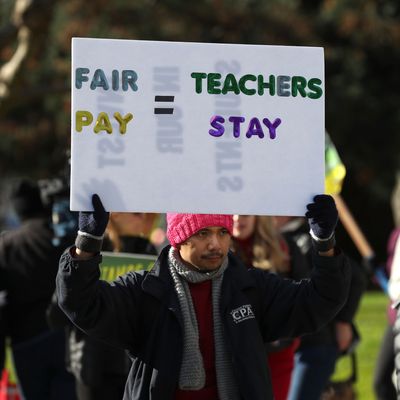
From a distance, last year’s RedforEd teacher walkouts may have seemed like a spontaneous expression of frustration or even desperation. In reality, though, the economic circumstances behind high-profile labor actions in West Virginia, Kentucky, Oklahoma, and elsewhere had been building for years, and so had the organizing efforts that helped bring those walkouts to life. The National Education Association’s latest edition of its annual Rankings & Estimates report, released on Monday morning, adds context to the origins of the RedforEd movement and affirms the complaints of protesting teachers. As teachers walked into their classrooms for the start of the 2017–18 academic year, they could expect to be paid far less than college graduates in other professional fields.
The NEA, which represents around 3 million members, found that American public-school teachers made an average salary of $60,477. But salaries vary from state to state and from school district to school district. Classroom teachers in New York made $84,227 on average; in Oklahoma, a walkout state, that same figure plummeted to $46,300. Even considering differences in living costs, Oklahoma’s average salary may not be a living wage for teachers, especially if they have families to support. Circumstances were even less auspicious for teachers just starting out in the profession. The NEA report found that 60 percent of educators worked in school districts that pay new teachers at least $40,000, but 288 school districts paid a starting salary of less than $30,000 a year. Nationally, the average starting salary for a teacher with a bachelor’s degree was $39,249. On paper, that’s a small increase from last year’s average for that category — $38,701. But factoring in inflation, salaries for starting teachers actually declined 2.91 percent over the last decade. (Monday’s rankings, which NEA collected from 11,675 out of 14,007 school districts, reflect the 2017–18 academic year. Its estimates, which incorporate the 2018–19 school year, show projected wage increases in some walkout states, though they aren’t enough to offset an average decline in salary when figures are adjusted for inflation.)
American wages have been slow to recover since the 2008 recession overall, but teacher salaries remain notably low. The left-leaning Economic Policy Institute reported on Wednesday that weekly wages for public-school teachers have steadily declined since the mid-1990s, even as wages rose for comparably educated professionals in other industries. Teachers earned, on average, 21.4 percent less than other college graduates in 2018, up from 5.3 percent in 1993. States simply aren’t paying new teachers enough to continue to attract people to the field, even though a national teacher shortage is gradually becoming more severe.
States that need teachers find themselves in a trap of their own making. The recession also can’t fully explain what EPI terms the teacher wage penalty, or the pay gap between public educators and college graduates in other fields. As EPI points out in its report, the wage penalty exists partly because of state-level policy decisions. Many state governments kept their education budgets low even as the economy’s health began to improve. Though cuts were concentrated in Republican-governed states, some traditionally Democratic states have failed to restore school-funding levels to their pre-recession standards. At the same time, a number of states have cut funding for public colleges and universities, which contributes to rising public-college tuition — and, inevitably, higher debt loads for teachers, who must figure out ways to pay off steep loans with salaries that would be inadequate even if they didn’t have any debt. According to one report from the Center for Budget and Policy Priorities, the State of Connecticut slashed its higher-education budget by 20.2 percent from 2008 to 2018. Delaware, where Democrats have controlled the executive branch and both chambers of the state legislature since 2009, cut higher-education funding by 26.2 percent over the same time period. In a call with reporters, NEA president Lily Eskelsen-Garcia said that when the union asks colleges of education why they’d experienced what she calls “a precipitous drop” in the number of prospective teachers, they cited low pay and student loans as deterrents.
State disinvestment in education might not be the only reason teachers remain so underpaid. Eskelsen-Garcia cited gender discrimination as another possible influence on the teacher wage penalty. “It occurs to me, especially as a woman elementary-school teacher, that you also have to look at the fact that we still have a pay gap between what are traditionally seen as primarily women’s professions and what are still primarily men’s professions, that women still earn 80 percent of men’s salaries,” she said. “It’s actually worse if you’re an educator. 76.6 percent of educators are women, and we have this increasing pay gap. No one can convince me that that’s a coincidence.”
Perhaps what’s most surprising about the RedforEd movement is that it didn’t happen sooner. Though there’s already some evidence that teachers won more school funding by walking out, the NEA’s report makes it clear that they’re fighting against pay inequities that have been entrenched for years. As teachers in South Carolina prepare for a day of protests on May 1, state governments should take heed. Walkouts will likely continue until working conditions finally – and permanently – improve.






























